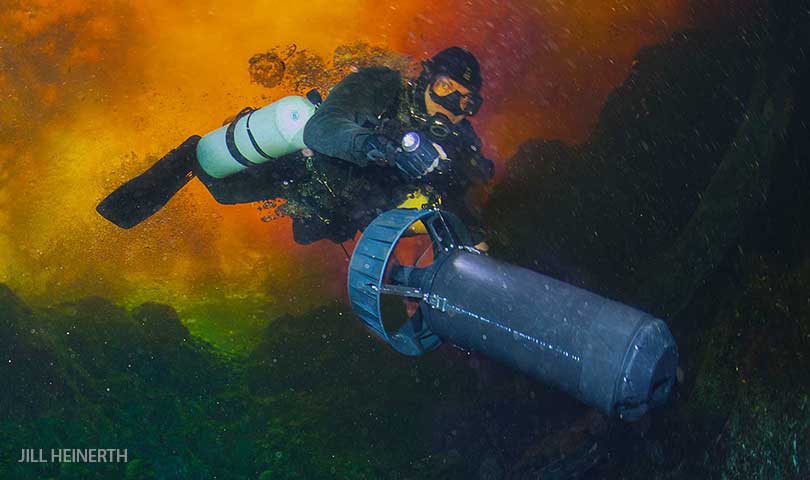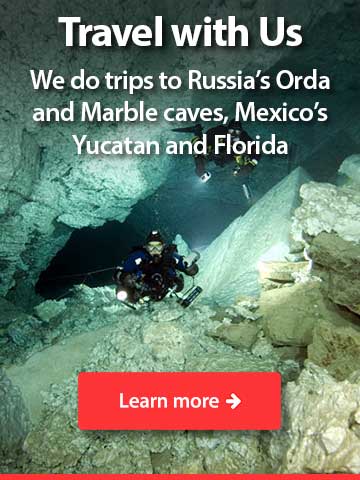DPV Cave Diver course

By far the most efficient way to extend your cave diving range is use of Diver Propulsion Vehicles (DPVs). You can use these by themselves or with stage bottles to go even further. Using DPVs in caves, however, can come with a price:
- A DPV can take you further into a cave in 10 minutes than you can swim out in 30 — and require a sixth as much air to do so, rendering the normal Rule of Thirds inadequate for safe gas management.
- If not careful, you can hit your head on the ceiling while scootering, hard enough to knock you unconscious — which, in a cave, is always fatal.
- Scooters can inconvenience or even injure other divers, and cause significant damage to the environment.
This is why DPVs are banned at some sites and, at others, allowed only if you possess DPV Cave Diver certification. Whether required or not, the risks of DPV use are such you would be crazy not to take this important course.
Who Can Take This Course?
To take this course, you must:
- Be at least 18 years old.
- Possess a minimum of full Cave Diver certification.
- Have logged at least 50 dives past Cave Diver certification.
- Possess Stage Cave Diver certification or equivalent.
- Either be able to answer No to all the questions on an industry-standard Medical History form or obtain a physician’s approval for diving before the start of the course. If you require a physician’s approval, the doctor must sign off on the standard Medical Exam form. Forms signed no more than twelve months before the start of the course are acceptable — provided you have had no change in medical history since then.
If you intend to take the course in north-central Florida, you must also be a fully certified cave diver. This is because the only sites possessing sufficient depth are inside caves.
What is Involved?
This course typically consists of:
This course consists of at least three training dives and 120 minutes of Actual Bottom Time.
Where Does the Course Take Place?
Assuming they already possess Cave Diver certification, most of our students do their training in north-central Florida’s freshwater springs and caves — however, you are by no means limited to this. We regularly conduct courses in Russia’s famous Orda system, the world’s largest underwater gypsum cave, as well as do training in Mexico’s cenotes. The choice is up to you.
How Much Does it Cost?
The exact cost of this program will depend on a variety of factors, such are:
- Will you be taking this course by yourself or with one or two other friends or family members?
- Are there any prerequisite courses you need to take in conjunction with this course?
- Where will you be taking the course? (Courses conducted in north-central Florida generally have the lowest cost.)
Once we determine your specific needs, we can give you a firm price for all the required training. Bear in mind, the course fees generally cover just the cost of instruction. You are responsible for:
- Transportation to and from the course location and dive sites.
- Any overnight accommodations and meals.
- Supplying all of the required equipment and gas fills.
By default, we certify cave students through NSS-CDS. If you want certification cards from additional agencies, you must pay the associated card processing fees. Any additional agency you choose generally requires you purchase their textbook or eLearning materials. This can add significantly to costs.
What Equipment Will You Need?
The minimum equipment requirements for most courses include:
- Mask and adjustable fins.
- Adequate exposure protection for the environment.
- Either back-mounted doubles or sidemount cylinders.
- Either a backplate/harness for backmount or an appropriate sidemount harness/air cell with adequate lift capacity.
- Two separate high-performance regulators.
- One primary and two backup lights.
- One primary reel per team; two safety reels/spools per diver.
- Jump reels/spools as required by the course.
- Three line arrows/cookies per diver.
- Two cutting tools per diver.
- Two depth gauge/timers or two mission-capable dive computers per diver.
- Cave-configured DPV.
Some very specific requirements pertain to each of these items. Do not make any equipment purchases without first speaking to your instructor.
Note: if you will be traveling by air to the course site, we can help you to arrange the rental of heavier items such as tanks at your destination.
How Do You Sign Up?
The best way to get started is to simply contact us.

